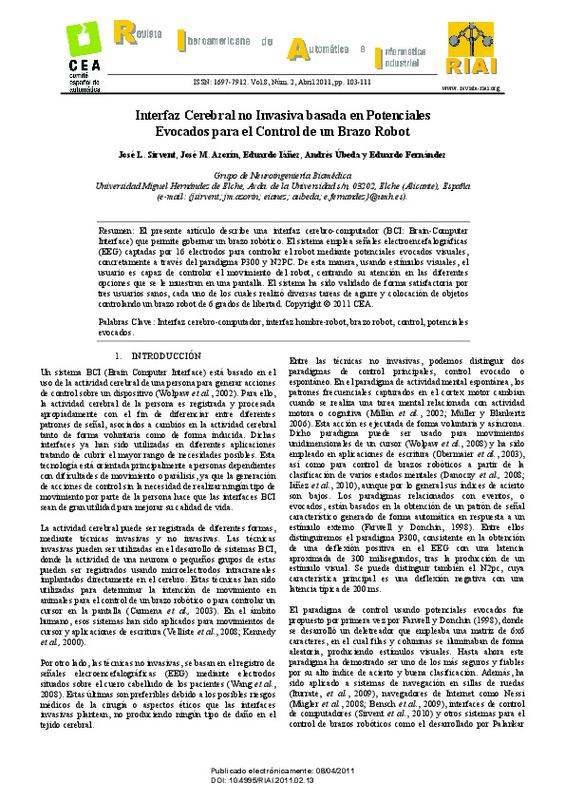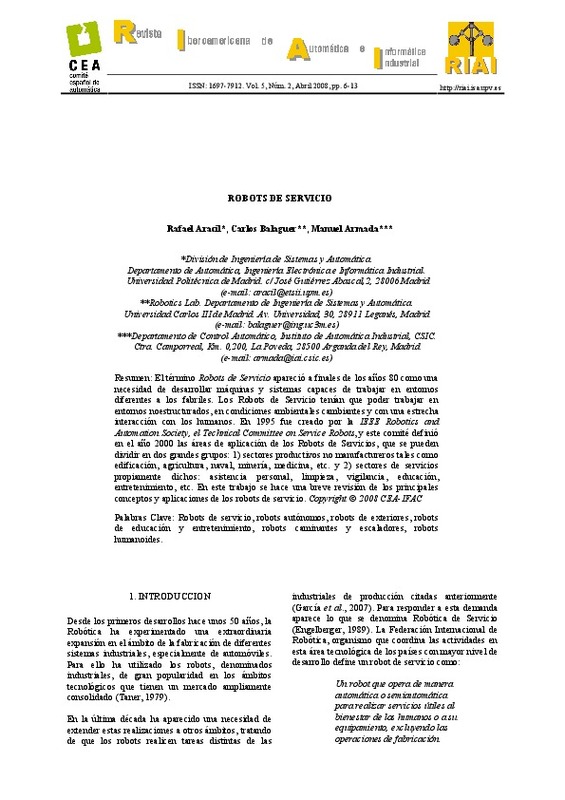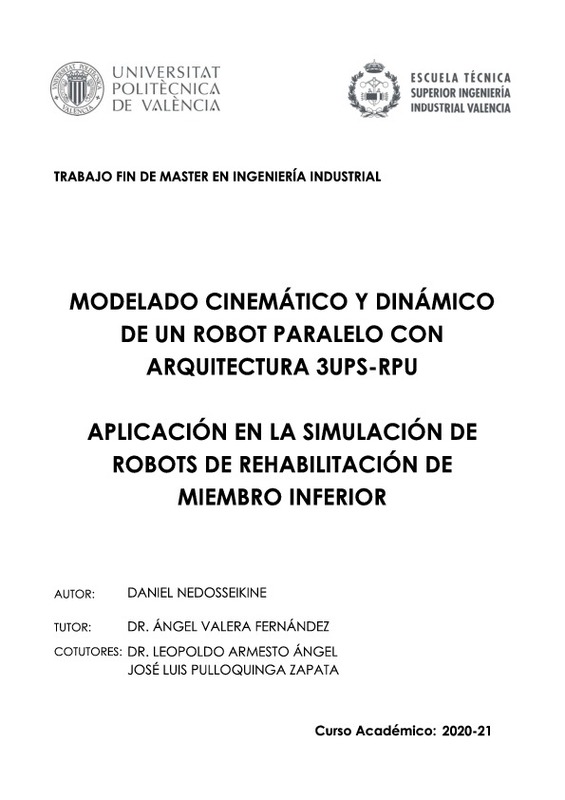JavaScript is disabled for your browser. Some features of this site may not work without it.
Buscar en RiuNet
Listar
Mi cuenta
Estadísticas
Ayuda RiuNet
Admin. UPV
Interfaz Cerebral no Invasiva Basada en Potenciales Evocados para el Control de un Brazo Robot
Mostrar el registro sencillo del ítem
Ficheros en el ítem
| dc.contributor.author | Sirvent, J. L.
|
es_ES |
| dc.contributor.author | Azorín, J. M.
|
es_ES |
| dc.contributor.author | Iáñez, Eduardo
|
es_ES |
| dc.contributor.author | Úbeda, Andrés
|
es_ES |
| dc.contributor.author | Fernández, Eduardo
|
es_ES |
| dc.date.accessioned | 2020-05-28T16:03:13Z | |
| dc.date.available | 2020-05-28T16:03:13Z | |
| dc.date.issued | 2011-04-08 | |
| dc.identifier.issn | 1697-7912 | |
| dc.identifier.uri | http://hdl.handle.net/10251/144531 | |
| dc.description.abstract | [ES] El presente artículo describe una interfaz cerebro-computador (BCI: Brain-Computer Interface) que permite gobernar un brazo robótico. El sistema emplea señales electroencefalográficas (EEG) captadas por 16 electrodos para controlar el robot mediante potenciales evocados visuales, concretamente a través del paradigma P300 y N2PC. De esta manera, usando estímulos visuales, el usuario es capaz de controlar el movimiento del robot, centrando su atención en las diferentes opciones que se le muestran en una pantalla. El sistema ha sido validado de forma satisfactoria por tres usuarios sanos, cada uno de los cuales realizó diversas tareas de agarre y colocación de objetos controlando un brazo robot de 6 grados de libertad. | es_ES |
| dc.description.abstract | [EN] This paper describes a Brain-Computer Interface (BCI) for controlling a robotic arm. The system uses electroencephalographic signals (EEG) recorded with 16 electrodes for controlling the robot with visual evoked potentials, using the P300 and N2pc paradigm. By this way, using visual stimuli, the user is able to control the robot movement focusing his attention in the different options shown in a screen. The system has been tested satisfactory by three healthy users. Each of them did several tasks of pick-and-place of objects, controlling a robot of 6 degrees of freedom. | es_ES |
| dc.description.sponsorship | Este trabajo ha sido realizado parcialmente gracias al apoyo del Ministerio de Ciencia e Innovación del Gobierno de España con el proyecto DPI2008-06875-C03-03 y de la Consellería d'Educació de la Generalitat Valenciana con la beca BEST/2010/047. | es_ES |
| dc.language | Español | es_ES |
| dc.publisher | Universitat Politècnica de València | es_ES |
| dc.relation.ispartof | Revista Iberoamericana de Automática e Informática industrial | es_ES |
| dc.rights | Reconocimiento - No comercial - Sin obra derivada (by-nc-nd) | es_ES |
| dc.subject | Brain-computer interface | es_ES |
| dc.subject | Human-robot interface | es_ES |
| dc.subject | Robotic arm | es_ES |
| dc.subject | Control | es_ES |
| dc.subject | Evoked potentials | es_ES |
| dc.subject | Interfaz cerebro-computador | es_ES |
| dc.subject | Interfaz hombre-robot | es_ES |
| dc.subject | Brazo robot | es_ES |
| dc.subject | Potenciales evocados | es_ES |
| dc.title | Interfaz Cerebral no Invasiva Basada en Potenciales Evocados para el Control de un Brazo Robot | es_ES |
| dc.title.alternative | Non-Invasive Brain-Computer Interface Based on Evoked Potentials for Controlling a Robotic Arm | es_ES |
| dc.type | Artículo | es_ES |
| dc.identifier.doi | 10.1016/S1697-7912(11)70031-0 | |
| dc.relation.projectID | info:eu-repo/grantAgreement/MICINN//DPI2008-06875-C03-03/ES/CONTROL DE SISTEMAS TELEROBOTICOS MEDIANTE INTERFACES AVANZADAS PARA PERSONAS DISCAPACITADAS/ | es_ES |
| dc.relation.projectID | info:eu-repo/grantAgreement/GVA//BEST%2F2010%2F04/ | es_ES |
| dc.rights.accessRights | Abierto | es_ES |
| dc.description.bibliographicCitation | Sirvent, JL.; Azorín, JM.; Iáñez, E.; Úbeda, A.; Fernández, E. (2011). Interfaz Cerebral no Invasiva Basada en Potenciales Evocados para el Control de un Brazo Robot. Revista Iberoamericana de Automática e Informática industrial. 8(2):103-111. https://doi.org/10.1016/S1697-7912(11)70031-0 | es_ES |
| dc.description.accrualMethod | OJS | es_ES |
| dc.relation.publisherversion | https://doi.org/10.1016/S1697-7912(11)70031-0 | es_ES |
| dc.description.upvformatpinicio | 103 | es_ES |
| dc.description.upvformatpfin | 111 | es_ES |
| dc.type.version | info:eu-repo/semantics/publishedVersion | es_ES |
| dc.description.volume | 8 | es_ES |
| dc.description.issue | 2 | es_ES |
| dc.identifier.eissn | 1697-7920 | |
| dc.relation.pasarela | OJS\8577 | es_ES |
| dc.contributor.funder | Ministerio de Ciencia e Innovación | es_ES |
| dc.contributor.funder | Generalitat Valenciana | es_ES |
| dc.description.references | &NA; (1991). American Electroencephalographic Society Guidelines for Standard Electrode Position Nomenclature. Journal of Clinical Neurophysiology, 8(2), 200-202. doi:10.1097/00004691-199104000-00007 | es_ES |
| dc.description.references | Carmena, J. M., Lebedev, M. A., Crist, R. E., O’Doherty, J. E., Santucci, D. M., Dimitrov, D. F., … Nicolelis, M. A. L. (2003). Learning to Control a Brain–Machine Interface for Reaching and Grasping by Primates. PLoS Biology, 1(2), e42. doi:10.1371/journal.pbio.0000042 | es_ES |
| dc.description.references | Covington, J. W., & Polich, J. (1996). P300, stimulus intensity, and modality. Electroencephalography and Clinical Neurophysiology/Evoked Potentials Section, 100(6), 579-584. doi:10.1016/s0168-5597(96)96013-x | es_ES |
| dc.description.references | Farwell, L. A., & Donchin, E. (1988). Talking off the top of your head: toward a mental prosthesis utilizing event-related brain potentials. Electroencephalography and Clinical Neurophysiology, 70(6), 510-523. doi:10.1016/0013-4694(88)90149-6 | es_ES |
| dc.description.references | Iáñez, E., Azorín, J. M., Úbeda, A., Ferrández, J. M., & Fernández, E. (2010). Mental tasks-based brain–robot interface. Robotics and Autonomous Systems, 58(12), 1238-1245. doi:10.1016/j.robot.2010.08.007 | es_ES |
| dc.description.references | Iturrate, I., Antelis, J. M., Kubler, A., & Minguez, J. (2009). A Noninvasive Brain-Actuated Wheelchair Based on a P300 Neurophysiological Protocol and Automated Navigation. IEEE Transactions on Robotics, 25(3), 614-627. doi:10.1109/tro.2009.2020347 | es_ES |
| dc.description.references | Johnson, G. D., & Krusienski, D. J. (2009). Ensemble SWLDA Classifiers for the P300 Speller. Lecture Notes in Computer Science, 551-557. doi:10.1007/978-3-642-02577-8_60 | es_ES |
| dc.description.references | Kiss, M., Van Velzen, J., & Eimer, M. (2008). The N2pc component and its links to attention shifts and spatially selective visual processing. Psychophysiology, 45(2), 240-249. doi:10.1111/j.1469-8986.2007.00611.x | es_ES |
| dc.description.references | Krusienski, D. J., Sellers, E. W., Cabestaing, F., Bayoudh, S., McFarland, D. J., Vaughan, T. M., & Wolpaw, J. R. (2006). A comparison of classification techniques for the P300 Speller. Journal of Neural Engineering, 3(4), 299-305. doi:10.1088/1741-2560/3/4/007 | es_ES |
| dc.description.references | Luck, S. J., Heinze, H. J., Mangun, G. R., & Hillyard, S. A. (1990). Visual event-related potentials index focused attention within bilateral stimulus arrays. II. Functional dissociation of P1 and N1 components. Electroencephalography and Clinical Neurophysiology, 75(6), 528-542. doi:10.1016/0013-4694(90)90139-b | es_ES |
| dc.description.references | Millán, J. del R., Franzé, M., Mouriño, J., Cincotti, F., & Babiloni, F. (2002). Relevant EEG features for the classification of spontaneous motor-related tasks. Biological Cybernetics, 86(2), 89-95. doi:10.1007/s004220100282 | es_ES |
| dc.description.references | Muller, K.-R., & Blankertz, B. (2006). Toward noninvasive brain-computer interfaces. IEEE Signal Processing Magazine, 23(5), 128-126. doi:10.1109/msp.2006.1708426 | es_ES |
| dc.description.references | Obermaier, B., Muller, G. R., & Pfurtscheller, G. (2003). «Virtual keyboard» controlled by spontaneous EEG activity. IEEE Transactions on Neural Systems and Rehabilitation Engineering, 11(4), 422-426. doi:10.1109/tnsre.2003.816866 | es_ES |
| dc.description.references | Schalk, G., McFarland, D. J., Hinterberger, T., Birbaumer, N., & Wolpaw, J. R. (2004). BCI2000: A General-Purpose Brain-Computer Interface (BCI) System. IEEE Transactions on Biomedical Engineering, 51(6), 1034-1043. doi:10.1109/tbme.2004.827072 | es_ES |
| dc.description.references | Velliste, M., Perel, S., Spalding, M. C., Whitford, A. S., & Schwartz, A. B. (2008). Cortical control of a prosthetic arm for self-feeding. Nature, 453(7198), 1098-1101. doi:10.1038/nature06996 | es_ES |
| dc.description.references | Yijun Wang, Xiaorong Gao, Bo Hong, Chuan Jia, & Shangkai Gao. (2008). Brain-Computer Interfaces Based on Visual Evoked Potentials. IEEE Engineering in Medicine and Biology Magazine, 27(5), 64-71. doi:10.1109/memb.2008.923958 | es_ES |
| dc.description.references | Wolpaw, J. R., McFarland, D. J., Neat, G. W., & Forneris, C. A. (1991). An EEG-based brain-computer interface for cursor control. Electroencephalography and Clinical Neurophysiology, 78(3), 252-259. doi:10.1016/0013-4694(91)90040-b | es_ES |
| dc.description.references | Wolpaw, J. R., Birbaumer, N., McFarland, D. J., Pfurtscheller, G., & Vaughan, T. M. (2002). Brain–computer interfaces for communication and control. Clinical Neurophysiology, 113(6), 767-791. doi:10.1016/s1388-2457(02)00057-3 | es_ES |











